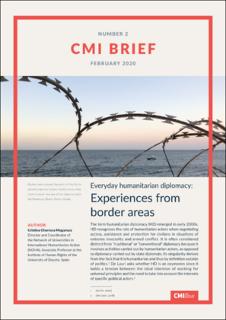| dc.description.abstract | The term humanitarian diplomacy (HD) emerged in early 2000s. HD recognises the role of humanitarian actors when negotiating access, assistance and protection for civilians in situations of extreme insecurity and armed conflict. It is often considered distinct from “traditional” or “conventional” diplomacy because it involves activities carried out by humanitarian actors, as opposed to diplomacy carried out by state diplomats. Its singularity derives from the fact that it is humanitarian and thus by definition outside of politics (Smith, 2007). De Lauri asks whether HD is an oxymoron since it holds a tension between the ideal intention of working for universal principles and the need to take into account the interests of specific political actors (De Lauri, 2018).
In a broad sense, HD can be defined “as persuading decision makers and leaders to act, at all times and in all circumstances, in the interest of vulnerable people and with full respect for fundamental humanitarian principles” (De Lauri, 2018: 1). A main feature of HD is exactly to understand what the interests of vulnerable people are in practice. However, we cannot always take for granted that HD is achieved with full respect to the core humanitarian principles (humanity, impartiality, neutrality, independence). In fact, this is an aspect that constantly needs to be addressed.
This policy brief argues that HD is not distinct from other forms of diplomacy. HD is a manifestation of the pluralisation of modern diplomacy. Modern diplomacy operates not only through a variety of practices and actors in institutional settings, but also in an ever-increasing variety of spaces in daily life activities. Everyday humanitarian diplomacy such as, for example, the practice of accompanying and representing border crossers vis-a-vis state and transnational authorities is a form of diplomacy conducted to support migrants and refugees in detention centres, in r | |
